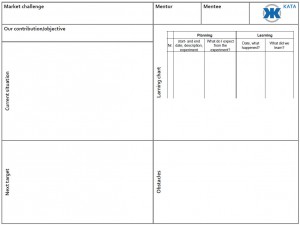Continuous improvement with KATA
The saying “standing still is a step backwards” adds extra importance to Kuhn Special Steel’s policy of continuously developing new processes and improving existing ones. Continue reading
We implemented an initiative known by its German initials “KKVP” (standing for “Kuhn’s continuous improvement process”) several years ago, along with an in-house suggestion scheme, with a view to supporting and encouraging the ongoing optimisation of our company. We have gone a step further in the same direction this year, by introducing the KATA system on our premises.
The origins of the term “KATA” lie in an Asian martial art based on the development of thought and behaviour by the constant practice of certain routines, to such an extent that they turn into virtually natural reflexes. Its application in a corporate context is concerned with routines designed to develop continuous improvement. KATA does not compete with existing systems therefore, but serves rather to extend them. This makes KATA ideal for tackling problems/objectives for which there is no previously known solution. KATA is a learning routine with a set of gradual and experimental target stages, which seeks to create a vision. Possible ideas for solutions are sought, tried out and used as a basis for learning. Everything is based on an approach summed up by the motto: small steps in the right direction.
The problems posed are dealt with by a mentor-mentee team, which exchanges experiences, in the course of daily KATA sessions, on the current progress of the project. These sessions follow a standardised question format designed to encourage the advancement of the project, take advantage of learned experience and develop new ideas. The so-called “KATA Board” supports and visualises these exchanges. It does so with a scoreboard approach that illustrates the current situation, sets the objectives being aimed  for and identifies any current obstacles likely to prevent their fulfilment. A space is also set aside for the so-called “learning chart”. This is used to list the experiments carried out and the results achieved, thereby allowing everyone in the company to gain a quick overview of the current status of the project and contribute ideas as required.
for and identifies any current obstacles likely to prevent their fulfilment. A space is also set aside for the so-called “learning chart”. This is used to list the experiments carried out and the results achieved, thereby allowing everyone in the company to gain a quick overview of the current status of the project and contribute ideas as required.
Self-testing carried out by four pilot teams has convinced us of the viability of this approach. The mentors and mentees received training, and were then engaged – in the context of the KATA project – to tackle various issues affecting our manufacturing and foundry operations. After a familiarisation phase largely concerned with taking in the new methodology and adapting it to day-to-day life at Kuhn Special Steel, all teams were quickly able to deliver initial successes with regard to the challenges that had been set. While an analysis of the current situation revealed that things were often more difficult than had been expected, thereby requiring a certain amount of running-in for the KATA process, the effort involved was rewarded with some interesting insights and even a few “Wow!” moments. These experiences are exchanged in the course of regular reflective-discussion workshops, with a view to letting this methodology benefit further areas of the company in the future.
Additional KATA teams have meanwhile been set up in the wake of this impressive success on the part of the initial groups, with the intention of improving our processes on a continuous basis. We are happy with the results, and are looking forward to seeing what KATA can achieve in the near future.
Photos: © auris – stock.adobe.com

